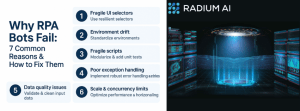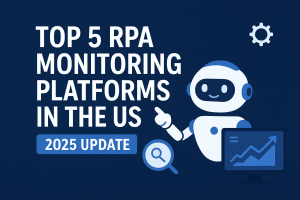Optimization of RPA: Balancing Costs and Performance
The rising cost of maintaining and scaling RPA (Robotic Process Automation) bots is presenting a growing challenge. A key discussion among RPA professionals is how to remain relevant in the business while continuing to derive value from the work done over the past 5-6 years.
In the early stages of RPA adoption, success was measured primarily by the number of bots implemented across the organization. This was often touted in executive circles as a metric of achievement. RPA license providers capitalized on this by overselling licenses, without sufficiently addressing the relevance of automation for each specific use case.
However, the increasing costs associated with RPA licenses, the virtual machines (VMs) required to host BOTs, and the rising expenses for BOTs maintenance and change management have forced to reassess automation journey. There is need to identify challenges created by the unplanned growth of bots and address them strategically. Here are key areas to focus on:
1. BOT Performance Management: Evaluate Bots Like Employees: Just as we evaluate the performance of human employees, bots should be regularly assessed based on transaction volume, business exceptions, and technical issues. Identifying underperforming bots and placing them under a Performance Improvement Plan (PIP) is crucial. If performance does not improve post-PIP, consider retiring the bot to save costs and resources.

2. Continuous Improvement: Eliminate Waste in Processes:Automation should not be an excuse to perpetuate inefficient processes. With the evolving needs of the business, there’s always an opportunity to revisit and refine processes regularly, challenging every step to eliminate waste and inefficiencies. Retire the BOTs which not being appropriately utilized or process can be eliminated.
3. Upgrade Applications: Assess the Long-Term Viability of Bots: Bots were initially positioned as a low-cost solution to bridge gaps in ERP systems or applications. However, increasing license and maintenance costs have proven otherwise. While bots can be a temporary bridge, it’s important to continuously evaluate opportunities to address these gaps directly within the application itself, reducing reliance on bots.
4. Tactical Automation: Diversify Your Automation Approach: Avoid onboarding all automation onto an RPA platform. Explore alternative methods to automate tactical processes or tasks using open-source tools or low-cost in-house solutions. This allows for more flexibility and cost efficiency.
5. License Optimization: Focus on Efficiency Over Volume: The number of bots and licenses are no longer reliable metrics for measuring automation success. Instead, focus on optimizing bot schedules to avoid idle time. Unlike humans, bots can work 24/7, but many organizations miss this benefit due to data availability issues, application accessibility, or inefficient scheduling. Key steps for optimizing bot usage include:
–SLA Considerations: If a process can be completed overnight after input is provided, delay bot execution to off-peak hours to reduce load on applications and improve performance.
– Cross-Functional Usage: Rather than segmenting bots by function, leverage the full potential of your bot licenses. If a bot has unused capacity, repurpose it for other business functions.
– Track Actual BOT Runtime: Monitor actual runtime against scheduled time. If a bot isn’t fully utilizing its scheduled window, dynamically allocate the license to other processes to improve efficiency.

6. Infrastructure Optimization: Consider the Full Cost of Infrastructure: The cost of infrastructure for building, deploying, and running bots is often overlooked. To sustain automation in the long term, it’s important to continuously optimize infrastructure costs. Key areas to focus on include:
– Attended Bots: Evaluate whether certain processes can be shifted to attended automation, where bots run on employee systems instead of virtual machines, potentially reducing infrastructure and license costs.
– Citizen Development: Empower business users to build simple automations with little or no technical expertise. By training business teams under the digital team’s governance and framework, you can unlock significant efficiencies while keeping costs low.
– Dynamic Scheduling: For unattended bots, implement dynamic scheduling based on the availability of runtime clients, ensuring bots are used efficiently without unnecessary idle time.
In summary, while RPA bots have provided tremendous value in automating business processes, the rising costs of licenses, infrastructure, and maintenance require a more strategic, well-managed approach. By focusing on tactical automation, continuous process improvement, license and infrastructure optimization, and performance management, we can better sustain and grow our automation journey, ensuring it continues to deliver value in the years ahead.
Source of the article

Related Posts

Why RPA Bots Fail: 7 Common Reasons and How to Fix Them
Discover the 7 most common reasons RPA bots fail — and how proactive monitoring, error classification, and auto-healing can keep…
Read More
Top 5 RPA Monitoring Platforms in the USA (2025 Update)
Discover the top 5 RPA monitoring platforms in the US for 2025. Compare features, benefits, and find the best AI-driven…
Read More
How Leading Enterprises in the US & UK Reduced RPA Support Tickets by 50% Using Smart Remediation (Powered by Radium AI)
Discover how enterprises in the US & UK use Smart Remediation powered by Radium AI to cut RPA support tickets,…
Read More
Why Traditional RPA Monitoring Falls Short — and How Radium AI Solves It
Radium AI replaces manual RPA monitoring with intelligent automation, ML-driven classification, and auto-resolution across UiPath, AA, and Blue Prism bots.
Read More
2025 Industry Recap: How Automation and Generative AI Are Reshaping Enterprise IT
As we reach the halfway point of 2025, the automation and generative AI (GenAI) industries have undergone significant transformations. Emerging…
Read More
What Is the Best RPA Tool for Mid-Sized Companies?
In the growing world of automation, Robotic Process Automation (RPA) has become a strategic lever for organizations aiming to enhance…
Read More


